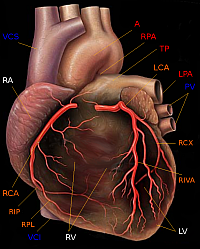Researchers at University of California in San Diego and Los Angeles, and Indiana University have discovered that irregular heart rhythms known as atrial fibrillation are the result of small electrical sources within the heart, in the form of spinning electrical rotors or focal beats. The research team published its findings online in the Journal of the American College of Cardiology.
The discovery made it possible to devise new ways of diagnosing and treating atrial fibrillation, which are the subject of a clinical study reported in the journal article. The technology has been licensed for commercial development by the University of California to Topera Medical, a start-up in San Diego.
The researchers led by UC San Diego’s Sanjiv Narayan uncovered what they believe are the underling sources of the irregular heart rhythms: tiny electrical disturbances in the heart called focal beats that look like spinning tops or rotors. Current treatments for atrial fibrillation are not often able to precisely target the cause, resulting in cases of the condition recurring.
The clinical study tested the new methods of treating atrial fibrillation against conventional treatments. The trial examined 107 patients referred for a non-surgical catheter ablation procedure, which involves threading a wire with a metal-tipped catheter through the body, and applying heat to the area of the heart producing the arrhythmia.
One group of patients in the study were treated with the new technique that performed small, precise burns called focal impulse and rotor modulation aimed at the focal beats. A second group of patients received the conventional catheter procedures. To track the outcomes, patients received an implanted electrocardiogram monitor that assessed their heart rhythms over time.
Narayan’s team discovered immediately the new procedure worked much faster than conventional treatments. They found the new methods shut down or significantly slowed atrial fibrillation in 86 percent of patients in an average of about 2.5 minutes. Conventional ablation procedures can take hours and normally involve larger areas of the heart.
The researchers found more of the patients receiving the new type of treatments had fewer recurrences of atrial fibrillation. After two years, 82 percent of the group with the new treatments were free from atrial fibrillation episodes, compared to 45 percent in the group that received the standard therapy.
Narayan is a co-founder of Topera Medical and co-author Wouter-Jan Rappel of UC San Diego owns an equity interest in the company. The company is developing a product called Rhythm View that provides a 3D graphical display of the right and left atrial electrical activity to detect abnormal heart rhythms. In March 2011, Topera Medical received premarket notification clearance from the Food and Drug Administration for the Rhythm View workstation.
Read more:
- Alcohol Consumption Indicated as Atrial Fibrillation Cause
- Researchers Develop Low-Energy Cardiac Defibrillation
- Robotic Catheter to Treat Cardiac Condition in Development
* * *


 RSS - Posts
RSS - Posts
You must be logged in to post a comment.